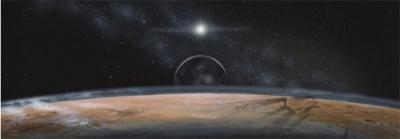The New Horizons mission to Pluto and Charon is on schedule. The spacecraft is now completely assembled and has undergone a comprehensive performance test of its own systems and its seven instruments, according to principal investigator Alan Stern. The first of the major flight mission simulations began at the end of April; this will be followed by another run of performance tests, with environmental testing beginning in mid-May. Eying the January 2006 launch window, NASA plans a readiness review at the end of May.

Image: Pluto and Charon are primary targets for this first targeted Kuiper Belt mission. Credit: Johns Hopkins University Applied Physics Laboratory.
Stern’s contributions to the New Horizons site at Johns Hopkins University’s Applied Physics Laboratory are a great way to keep up with the mission’s progress. In the latest, Stern recalls how New Horizons got its name:
…as I waited for a streetlight to change near the intersection of Foothills and Arapahoe and looked west to the Rocky Mountains on the horizon, it just hit me. We could call it “New Horizons”— for we were seeking new horizons to explore at Pluto and Charon and the Kuiper Belt, and we were pioneering new horizons programmatically too as the first-ever PI-led outer planets mission.
More New Horizons news at the site, where Stern’s updates can be followed monthly.
Assuming New Horizons passes its environmental and launch risk analysis and launches as planned on January 11, 2006, the next mission milestone will be a gravity assist near Jupiter in February of 2007. New Horizons is scheduled for a much closer approach than Cassini’s, coming within about 32 Jupiter radii of the giant planet at some 21 kilometers per second. The gravity assist will be followed by the eight-year cruise to encounter at Pluto/Charon, with further Kuiper Belt investigations to follow.
Centauri Dreams note: in the eyes of many investigators, Pluto and Charon themselves are Kuiper Belt objects, probably the largest in this vast reserve of icy objects extending past the orbit of Pluto out to roughly 50 AU. While both Pluto and Charon have solid surfaces, they differ from the rocky terrestrial planets in the amount of icy material — carbon dioxide, frozen water, methane, molecular nitrogen and carbon monoxide — that makes up their mass. Getting to know these objects, and comparing them to what we know about cometary nuclei, will tell us much about the formation of the Solar System.
Note that a secondary launch window exists in the first two weeks of February, 2007. If used, the secondary window would see New Horizons put into a direct trajectory to Pluto (no Jupiter gravity assist), with arrival in late 2019 or early 2020, depending on the exact launch date.

